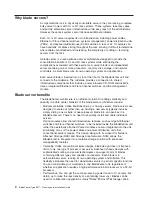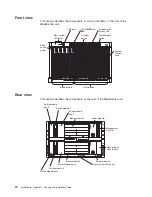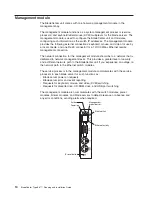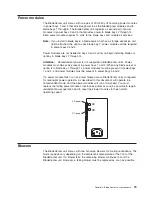
Why
blade
servers?
As
organizations
look
to
physically
consolidate
servers,
they
are
looking
to
replace
bulky
server
towers
with
1U
or
2U
rack
systems.
These
systems
take
less
space
and
put
the
enterprise
server
infrastructure
within
easy
reach
of
the
administrator.
However,
these
rack
systems
also
introduce
additional
problems.
Each
1U
or
2U
server
requires
its
own
infrastructure,
including
power
cables,
Ethernet
or
Fibre
Channel
switches,
systems
management,
power
distribution
units
(PDUs),
and
keyboard/video/mouse
(KVM)
switches.
A
rack
of
42
1U
servers
can
have
hundreds
of
cables
strung
throughout
the
rack,
making
it
difficult
to
determine
where
cables
are
attached
and
increasing
the
complexity
of
adding
or
removing
servers
from
the
rack.
A
blade
server
is
a
rack-optimized
server
architecture
designed
to
provide
the
consolidation
benefits
of
1U
and
2U
rack
systems
while
eliminating
the
complications
associated
with
these
systems.
A
server
blade
is
an
independent
server
containing
one
or
more
processors,
memory,
disk
storage,
and
network
controllers.
A
server
blade
runs
its
own
operating
system
and
applications.
Each
server
blade
is
inserted
into
a
slot
at
the
front
of
the
BladeCenter
unit
and
connects
to
the
midplane.
The
midplane
provides
a
connection
to
shared
infrastructure
components
that
includes,
power,
blowers,
CD-ROM
and
diskette
drives,
integrated
Ethernet
and
Fibre
Channel
switches,
and
the
management
module.
Blade
server
benefits
The
BladeCenter
architecture
is
an
efficient
solution
for
adding
scalability
and
capacity
in
a
data
center.
Benefits
of
the
blade
server
architecture
include:
v
Modular
scalability.
Unlike
traditional
8-way
or
16-way
servers,
blade
servers
are
designed
to
scale
out
rather
than
up.
Adding
a
new
server
typically
involves
simply
sliding
a
new
single
or
dual-processor
blade
into
an
open
bay
in
a
BladeCenter
unit.
There
is
no
need
to
physically
install
and
cable
individual
servers.
Option
modules
allow
shared
infrastructure
features,
such
as
Gigabit
Ethernet
switches
and
Fibre
Channel
switches,
to
be
included
inside
the
BladeCenter
unit
rather
than
externally
attached.
Power
modules
are
also
integrated
into
the
unit
eliminating
many
of
the
power
cables
and
power
distribution
units
that
conventional
servers
require.
This
design
along
with
its
support
for
Network
Attached
Storage
(NAS)
and
Storage
Area
Networks
(SAN)
allows
the
BladeCenter
to
integrate
into
a
scalable
storage
solution
with
enhanced
manageability
features.
v
Versatility.
Unlike
conventional
server
designs,
blade
design
does
not
impose
a
limit
of
only
one
type
of
processor
per
server.
Advanced
chassis
designs
with
sophisticated
cooling
and
power
technologies
can
support
a
mix
of
blades
containing
different
types
and
speeds
of
processors.
Each
blade
is
a
self-contained
server,
running
its
own
operating
system
and
software.
This
flexibility
eliminates
the
need
for
standalone
servers
to
perform
specific
functions.
You
can
consolidate
your
workloads
in
one
BladeCenter
unit,
regardless
of
whether
an
application
requires
a
high-performance
64-bit
processor
or
a
32-bit
processor.
v
Performance.
You
can
get
the
same
processing
power
found
in
1U
servers,
but
obtain
up
to
twice
the
rack
density
at
a
potentially
lower
cost.
Blades
can
be
used
for
collaboration
applications
(Lotus
®
Notes
™
Microsoft
®
Exchange),
Web
4
BladeCenter
Type
8677:
Planning
and
Installation
Guide
Summary of Contents for 8677 - BladeCenter Rack-mountable - Power Supply
Page 1: ...BladeCenter Type 8677 Planning and Installation Guide GA27 4327 01 ERserver...
Page 2: ......
Page 3: ...BladeCenter Type 8677 Planning and Installation Guide GA27 4327 01 ERserver...
Page 6: ...iv BladeCenter Type 8677 Planning and Installation Guide...
Page 10: ...viii BladeCenter Type 8677 Planning and Installation Guide...
Page 94: ...84 BladeCenter Type 8677 Planning and Installation Guide...
Page 122: ...112 BladeCenter Type 8677 Planning and Installation Guide...
Page 125: ......
Page 126: ...Printed in USA GA27 4327 01...













































